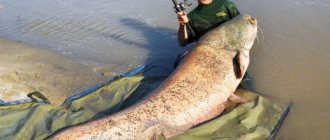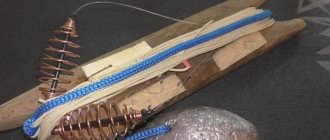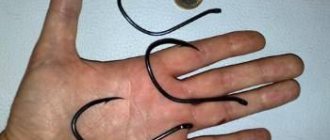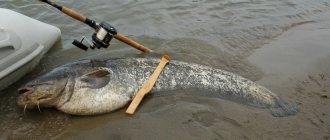Anglers with many years of experience know that fishing for catfish using the liver is an extremely catchy way to catch fish. Despite the fact that this river giant is impressive in size and sometimes intimidates fishermen, it is not at all averse to eating food waste, including chicken liver. Such a bait has one significant drawback - due to its specific consistency, it is quite difficult to place the liver on the hook, but even if this can be done, it will last only a few minutes, and then it will begin to fall apart. In order not to be left without a catch and not to waste time, you need to know how to catch catfish using chicken liver.
Fishing tips
Regardless of what bait you use to catch channel catfish, you need to know what time to fish and what body of water to choose. As practice shows, river giants are not found in every reservoir, so catching them can be quite difficult.
To ensure that catching catfish on the liver is not unsuccessful, you must consider the following tips:
- If you plan to fish for catfish, the optimal time for fishing is after midnight. Catfish become active and go in search of food only at night; during the day they prefer to lie down at the bottom;
- small and large individuals like to spend time close to the shore, in areas with well-warmed water. If there is such a place near the reservoir, you should definitely try to throw bait there;
- Since catfish do not have a picky taste, they can be caught using a variety of baits. But experienced fishermen claim that what attracts these fish most of all is the smell of feathers, singed wool and smoked meat;
- To create the most suitable conditions for fishing, you can use specialized aromatic baits, which are sold in almost every store today.
If you were unable to prepare for fishing in advance and stock up on everything you needed, you can simply quickly fry a piece of chicken meat over the fire (and it does not have to be fresh).
Collection of equipment
Since catfish are impressive in size and weight, it is easy to guess that the fish is very strong, so only very strong fishing rods should be used for fishing.
They must meet the following requirements:
- The fishing rod itself should not only be strong, but also have decent weight and bend well. The optimal fishing rod size is up to 2 m.
- As for the selection of a reel, in this case it is recommended to give preference to the animated version, since an ordinary inertia-free reel may not be able to cope with fishing for such large fish.
- Instead of fishing line, it is better to use high-quality braid, the thickness of which should be at least 0.5 mm. In this case, you need to expect that the braid will have to withstand a weight of up to 60 kg, the breaking force will also be decent.
- Hooks must be strong.
Collecting such equipment will cost the fisherman a decent amount, but otherwise it is almost impossible to catch catfish.
Liver fixation
After all, since the liver, especially defrosted, is quite soft, this problem is familiar to many fishermen. Some anglers cope with the task in a very specific way - they simply take with them portable refrigerators filled with ice, as a result of which the liver does not have time to completely defrost.
But the following methods of fixing bait have also proven themselves to be very good:
- using tee No. 8 or 10. If the liver is carefully placed on each hook, it will not fall apart for a long time. The undoubted advantage of the method is that you can plant both frozen and thawed liver;
- using a nylon sock. The “treat” is wrapped in a sock, after which the product is fixed to the hook. Since nylon is a very thin but durable material, it will not prevent the spread of odor, but will not allow the liver to fall apart.
Bait made from chicken liver mixed with wheat flour also worked very well. The ingredients will need to be mixed in equal proportions, formed into balls and also placed on the tees.
orybalke.com
Salo
The predator can be successfully caught in winter using fresh lard, which is cut into cubes and placed on a jig. By the way, roaches can also be tempted by lard. If you don’t have fresh lard, you can use salted lard, but you just need to thoroughly remove the salt from it.
In order for the fat to stay on the hook better and, accordingly, the fish to be hooked well, it must be cut off from the belly. There is no need to take solids for these purposes. When fishing with lard, small fish are cut off.
Before using this bait, it is advisable to soak the cut pieces in water. In the absence of sprat, pike perch can be caught well in winter using lard, and when setting out on the first ice to catch rotan, you simply need to take this bait with you.
Advantages of the nozzle
Undoubtedly, the main advantages of the nozzle include its dual action. After all, the product, due to its composition and structure, simultaneously plays the role of bait and the role of a direct attachment. Soft, filled with juice, which is based on the blood of the animal, with a strong aroma, the liver lures a mustachioed predator to the fishing point from great distances. This effect of spreading an odorous plume is used especially well in bodies of water with a current. In such places, this catfish bait lures the giant out of even its most distant hiding places, allowing you to place fishing gear in the shallows, in convenient places, where installation control is under constant supervision and it is easier to pull the caught fish out of the water.
Availability of the product also plays an important role. After all, fresh liver kits can be purchased indefinitely in the meat department of any grocery store, and their cost is not particularly expensive, especially in comparison with the purchase of baitfish or bindweed.
Important! One of the advantages of livers is the ability to mix the product with other types of vegetable baits, in particular flour and semolina, which gives working combinations that are as effective as live bait.
How to preserve your liver while fishing
Difficulties in fishing are caused by storing the product, especially if the fishing session lasts several days during the hot period of the year. By freezing the giblets before leaving, the fisherman can initially benefit from hooking a product with a dense consistency. But over time, the liver loses these qualities and becomes a crumbly, friable substance that easily falls apart.
Taking into account modern possibilities, the presence of a car when fishing and the purchase of a stationary mini-fridge, it does not seem impossible to preserve a frozen product for a couple of days. But if fishing takes place in a remote place without the benefits of civilization, the fisherman will have to be smart. Using a portable refrigerator, which can be assembled from a metal box covered with foam panels, helps to guarantee the preservation of the liver for a couple of days.
Important! Before going fishing, plastic bottles with frozen water are placed in such a refrigerator, leaving free space for storing food. A tightly closed insulated box will keep it cold and keep the bait in perfect condition.
Such a device does not require electrical energy or special care; the main thing here is to monitor the tightness of the closed lid, not allowing external heat to penetrate inside the box.
How to attach a liver to a chub hook
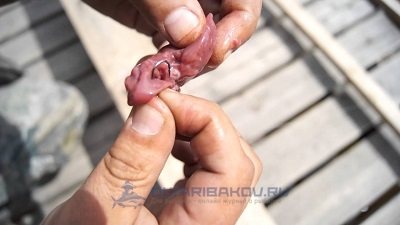
But there are planting methods that allow you to avoid such troubles. On the other hand, in many cases it is enough to simply put the bait on the hook, and special strength of the “installation” is not needed. Generally, each fisherman has his or her own favorite liver rigging method for each fishing situation.
It is enough to know the five main options to be able to choose from them:
- You can cut off a larger piece of liver and place it in such a way that the entire hook is inside, and only a small part of the forearm with the eye sticks out. With this option, the bait is held quite securely. In addition, thanks to the use of a volumetric nozzle, fines can be cut off. Since the sting is hidden inside the bait, the likelihood that a large, cautious chub will prick itself during a bite, get scared and throw the hook, is minimized. This method of baiting is especially suitable for situations where the chub is passive.
- Another option is to use a tee instead of a regular hook. The optimal size for catching chub is about 8. The liver must be placed in such a way that it is put on each of the three stings, this ensures a very reliable fixation. The points should remain open. In contrast to the previous option, this method of baiting is better suited for catching active chub. In addition to tees, doubles can be a good replacement for single hooks.
- After placing it on the hook, you can tie the liver with a thread. It is better to match it to the color of the bait so that it does not stand out visually. The thread is simply wrapped around a piece of the liver so that it is securely tied to the forend. You shouldn't expect a good result on the first try; you need a little practice to learn how to do it correctly.
- Another way is to place the liver in a piece of women's stockings, and then tie it with thread, making a kind of pouch. This option is used when fishing with a hair rig, which is relevant for hunting large chub.
- If liver in the form of dough is used as bait, you need to make balls from it and put them on hooks. The nozzle will hold much better on a tee, but a double or single will also work.
Selection of gear for catfish fishing
Fishing gear is selected not based on the type of bait, but based on the size of the possible catch. And as you know, catfish over 20–30 kilograms are not that uncommon, especially on large rivers, lakes and reservoirs. Using liver giblets, the bottom fishing method is used.
Important! In particular, the most comfortable option is to use a rubber donkey, which allows you to carefully deliver this delicate bait to the fishing point without hitting the water.
They fish with basic braided lines of 0.5-0.7 mm, with the installation of fluorocarbon half-meter leaders from 1 mm in diameter using a forged steel hook.
Because the bait is amorphous, the leash is not equipped with a swivel, thereby thinning the tackle. To hold the installation in a certain water horizon, the leashes are equipped with foam float bosses of various weights. When completing the bottom tackle formed on the fishing rod, powerful 3-meter feeder sticks are used, with weights from 150–200 grams. A slow action blank is suitable for wearing down powerful fish and reliably landing them.
Multiplier reels with high traction parameters make it easier to fight a trophy that has landed on a hook. A braided cord of 0.4-0.5 mm, a sliding weight and a hook number 2–4 with a shortened shank complete the equipment set. When using a leash, which is sometimes ignored by experienced fishermen who have the skill of slowly reeling in while controlling the course of the cord, you need to use a swivel, which prevents the bait and load from twisting at the time of winding the cord.
How to attach a liver for catching catfish
The method of fixing the chicken liver on the hook depends on the type of hook used. It is best to place frozen livers on tees, stringing a selected piece of product onto each tip in layers. In this form, the nozzle will remain in the water for at least two hours, after which it needs to be replaced.
Using single and double hooks, fishermen resort to tricks that make the bait more reliable in terms of its density.
I stuff this frozen product tightly into a nylon stocking, after which it becomes much easier to attach the liver to the tip of the sting. In addition to direct fitting, they use tying to a hook and fastening with rubber bands tied into a ring and, with their compression force, tightly pressing the nylon sausage to the fore-end. The nylon stocking does not reduce the effectiveness of the bait, since the trail of flavoring aromas continues to spread freely throughout the reservoir through the mesh of the material.
Another fastening method is based on mixing offal with flour. In this case, the crumpled livers are mixed with regular flour, obtaining plastic pellets, which are mounted on hooks.
Tulka
Small fish, such as sprat, are used as bait in winter. The pike perch really likes the sprat; burbot are also caught with it. Pike are often tempted by it.

The fish should be of “could-eat-it-yourself” quality, then it will stick well to the hook and not fall apart in the water. The sprat is placed on the hook with its tail and towards the fishing object with its head.
How to catch catfish with liver
Catching catfish using chicken, beef or pork liver is carried out according to the same principle. The fisherman selects a promising place for fishing and decides on the gear with which he will hunt. Depending on the type of gear and the strength of the current, the bait is prepared by making a mixture with flour or stuffing giblets into a nylon net. When installing rubber donks, problems with feeding baits into the fishing zone do not arise due to the design of the gear.
Important! Using casting hooks requires paying special attention to attaching the bait, because otherwise, already on casting, it can be lost either during a strong swing or when hitting the water.
After a successful cast, the bet is equipped with a signaling device and a bite is expected.
Important! If there are none, the attachment is checked at least once every two hours, adding or replacing completely with a new one.
The bites for giblets are sharp, as the catfish immediately sucks up the delicacy and immediately retreats to the shelter zone. They respond to the bite alarm with a sharp hook and, with noticeable tugs, begin to fish, trying to lift the giant as close to the surface of the water as possible, which is achieved by working the rod by increasing its lifting angle, winding the loose cord with the reel. Having pulled the fish to the shallows, the trophy is hooked under the gills with a long hook and dragged to the shore, where especially large specimens are stunned with a rubber hammer. Small items up to 10 kg are placed on a kukan without humanization.
iarybak.ru
How to Catch Catfish Using Chicken Liver
Catching catfish using chicken liver
Catfish is one of the most impressive, non-massive predatory fish living in freshwater bodies of Europe. This giant loves to feast on frogs and crayfish , various waterfowl, fish, and also food waste.
However, > the myth of a varied diet pales in comparison to the variety of baits that are used when fishing for catfish.
Among them, chicken liver is practically the most attractive for this purpose for a large predator. Fishing for catfish using the liver is a favorite technique of experienced fishermen.
Chicken liver as fishing bait
Such bait for chub and catfish will also be a desirable delicacy, the main thing is that the chicken liver is raw.
Tip: eating chicken liver in another form (boiled or scalded with boiling water) will reduce the effectiveness of biting, since the treated bait loses the smell of blood and the reddish color that attracts fish so much.
2.1 Methods for attaching chicken livers to a hook
- You can find detailed instructions on how to most effectively attach chicken livers to a hook and a double on one of our pages.
- The fresh liver is placed in a nylon stocking, pierced at the top and rotated around the hook and pierced with the tip of the hook. You can pre-tie the bait with thread.
- You can mix the bait with flour and pass the mixture through a blender (meat grinder), roll into balls and place on a hook. The flour will glue the mass together and prevent it from falling apart.
Read a detailed article about a fishing hook, its structure, features, types, methods of use and storage here
How to choose the right fishing hook, what key points you should not miss when purchasing, read this detailed article
2.2 Fishing technique when using chicken liver
When using chicken liver, the bait is cast downstream (35 degrees to the water flow). The hook must be sharp, as the fish can easily rip it off the hook, since the liver is not firmly held on the hook.
Liver preparation
Liver for chub fishing is used only fresh or quickly frozen (after defrosting, it practically does not lose its original state). During the fishing process, the liver needs to be changed more often, since it quickly becomes bleeding and washed away by the current, which is why it easily flies off the hooks.
Read! Fishing for perch in winter
To strengthen a piece of liver on a hook, pass the sting through the piece and tie it to the shank with a small dark thread. This way the bait holds much better.
When fishing with the liver, the stings of the hooks can rarely be completely hidden from the piece, but in any case, try not to let the hooks protrude too much. Chub is a cautious fish.




